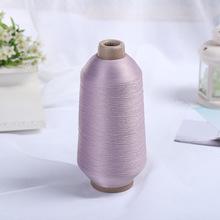What are the characteristics of nylon yarn?
Nylon is a synthetic fiber that can be made into long or short fibers. Nylon is a term for polyamide fiber (nylon), and its appearance has given textiles a completely new look. Its synthesis is a major breakthrough in the synthetic fiber industry. In today's society, with the development of science, synthetic fiber technology has also made significant progress. Synthetic fibers are widely used in industrial production such as textiles and clothing due to their good shaping effect, high strength, good elasticity, and strong wear and corrosion resistance.
aboutnylon colored yarnCharacteristics:
1. Due to its strong strength and wear resistance, it is commonly used as socks, gloves, and knitted sportswear.

2. Good elasticity, high strength, and high wear resistance, which are outstanding in current fiber applications.
3. Good moisture absorption, wear-resistant but not acid resistant, so nylon products are not easy to store with sanitary balls.
4. Poor light resistance, prone to yellowing and reduced strength when exposed to sunlight, therefore cotton products should not be dried after washing.
Article source: Nylon colored yarn
-
05-27
The reason why fabrics containing spandex are prone to yellowing
Spandex is a commonly used fiber variety in our daily lives, characterized by good elasticity, low fineness, high elastic modulus (cracking elongation can reach 400-800), and low specific gravity. Spa
-
04-24
Colored non dyed nylon with synthetic fiber raw material
The current conventional fiber coloring mostly uses yarn dyeing method, which has long process, high loss, high cost, and the product has color difference and low color wash fastness. Yarn is prone to
-
03-26
What are the characteristics of non dyed spandex?
Non dyed spandex has also been widely used in recent years. Non dyed spandex fiber can be blended with fibers such as nylon, polyester, acrylic, cotton, wool, etc., which can give fabrics excellent el
-
02-24
The influence of yarn structure on fabrics
The basic characteristics of yarn include its appearance and shape, twisting characteristics, fiber transfer and distribution characteristics in the yarn, as well as the surface fuzz and internal loos
